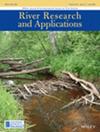利用二维建模和卫星图像研究一条受调控辫状河流的辫状强度和形态动力学变化的时间变化
IF 1.9
4区 环境科学与生态学
Q4 ENVIRONMENTAL SCIENCES
引用次数: 0
摘要
辫状河的河道形态相当复杂。高泥沙输运率和频繁变化的排水量是平面形态动态演变的原因。在过去的几十年里,科学界一直致力于了解交替横杆的共存以及随之出现的汇合点和分叉点,所有这些都与河岸侵蚀过程错综复杂地相互作用。要估算或预测这类河流的总泥沙输运率,尤其是在考虑到各种水文数据和气候影响的情况下,仍然具有相当大的挑战性。本研究的重点是阿尔巴尼亚德沃尔河位于班亚大坝上游的河段。由于大坝水库上游的三角洲不断扩大,了解该河段的形态动力学具有重要意义。本研究采用二维深度平均法,目的是研究德沃尔河辫状强度的时间变化,以及与上游大坝的调节水文图相比,使用水文数据中的排水水文图对河流形态动力学和泥沙输运的影响。在对 11 种不同的泥沙输运函数等各种参数进行评估后,本研究中单元大小为 5 × 5 m2、曼宁粗糙度系数为 0.03、Meyer-Peter 和 Müller 的泥沙函数、Hayashi 等人(1980 年)的隐藏函数以及 Van Rijn 河床粗糙度预测器的结果最佳。此外,对比卫星图像和 2019 年至 2023 年河流模型的结果表明,辫状指数有所下降,这可能是由于在上述期间,河流的实际情况与水文数据中的非管制排水量相比,有管制排水量。本文章由计算机程序翻译,如有差异,请以英文原文为准。
Temporal variation of braided intensity and morphodynamic changes in a regulated braided river using 2D modeling and satellite images
The river morphology of a braided‐type river is rather complex. High sediment transport rates and frequently changing discharges are the cause of dynamic planform evolution. Over the past few decades, scientific attention has been directed toward understanding the coexistence of alternating bars and the consequent emergence of confluences and divergences, all of which interact intricately with the process of bank erosion. It is still rather challenging to estimate or predict the total sediment transport rate in this type of river, especially by considering various hydrologic data and climate effects. This study is focused on the reach of the Devoll River in Albania, located upstream of the Banja dam. Understanding the morphodynamics of this river reach holds significance due to the expanding delta upstream of the dam reservoir. The objectives of the two‐dimensional depth‐averaged approach of the present study are to investigate the temporal variation of braided intensity of Devoll River and the effect of using a discharge hydrograph from hydrologic data compared to the regulated one from the upstream dam on the morphodynamics and sediment transport of the river. After evaluating various parameters such as 11 different sediment transport functions, the best results were reached for a cell size of 5 × 5 m2 , Manning roughness coefficient of 0.03, Meyer‐Peter and Müller's sediment function, Hayashi et al. (1980) hiding function, and Van Rijn bed roughness predictor in this study. In addition, the results of comparing satellite images and modeling the river from 2019 to 2023 show that the braided index decreased, and this can be due to the fact that the real scenario of the river has a regulated discharge compared to the non‐regulated discharge from hydrologic data, in the mentioned period.
求助全文
通过发布文献求助,成功后即可免费获取论文全文。
去求助
来源期刊

River Research and Applications
环境科学-环境科学
CiteScore
4.60
自引率
9.10%
发文量
158
审稿时长
6 months
期刊介绍:
River Research and Applications , previously published as Regulated Rivers: Research and Management (1987-2001), is an international journal dedicated to the promotion of basic and applied scientific research on rivers. The journal publishes original scientific and technical papers on biological, ecological, geomorphological, hydrological, engineering and geographical aspects related to rivers in both the developed and developing world. Papers showing how basic studies and new science can be of use in applied problems associated with river management, regulation and restoration are encouraged as is interdisciplinary research concerned directly or indirectly with river management problems.
 求助内容:
求助内容: 应助结果提醒方式:
应助结果提醒方式:


